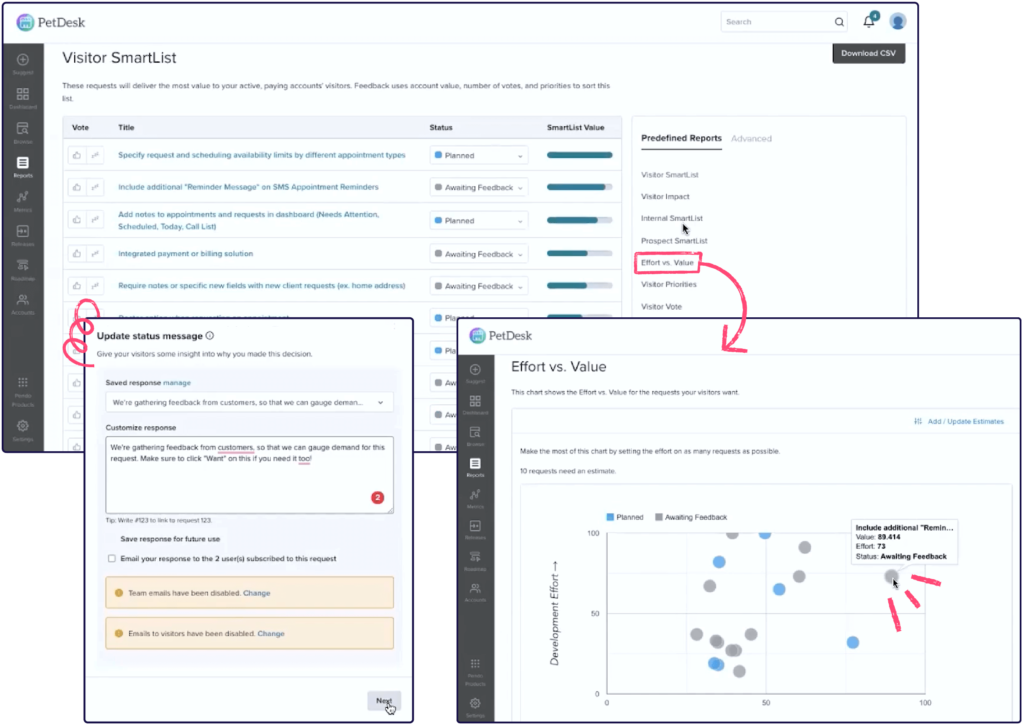Necessity is the mother of invention
単にユーザーからフィードバックを求めるのは1つの方法です。しかし、顧客フィードバックをプロダクト・顧客体験プロセスの中心に据えることは、まったく別のことです。Pendoは、チーム全体が状況を正しく把握し、誰もが容易に参画できるよう支援します。
PetDeskは、COVID-19パンデミックが発生する直前に、Pendoのアナリティクスとアプリ内ガイドを使い始めました。しかし、環境が一変したとき、適応の必要性を認識していました。「私たちはビジネスモデルを変更し、市場で何が起きているかというお客様の声に再び焦点を当てる必要がありました」と、PetDeskのプロダクトマネージャー、Shona Fenner氏は述べています。「私たちのお客樣は社会にとって不可欠なビジネスを担っているため、コミュニケーションのニーズは大きく変化しました。弊社は、そのニーズに応えるコミュニケーションプラットフォームを提供しています。私たちは方向転換を余儀なくされました。」
The pandemic was just one driving force behind PetDesk’s journey to becoming a more feedback-driven product organization. “We realized we needed a cohesive voice of the customer (VoC) solution, not just for what happened with COVID, but for everything,” said Fenner. “We’d touted ourselves on being data-driven and listening to customers, but we didn’t have a mechanism to do it very well.” The PetDesk team saw the value of building on the robust customer insights they had already started to gather within the Pendo platform—and decided to implement Pendo Feedback, too.
フィードバックに基づく対応
Fenner and her team wanted a VoC solution that could improve visibility across the organization and inspire PetDesk’s customer success teams to feel included in the product roadmapping process. They started with the goal of replacing their old internal-facing feedback collection tool—which relied on manual inputs and didn’t give stakeholders a clear line of sight into the outcomes of their requests. “I knew our team didn’t use the old solution, and I didn’t either, because I felt like I was screaming into a black hole,” said Fenner. “What helped us create buy-in [for Pendo Feedback] was making it super visible.”
Fenner and her team rolled out Pendo Feedback internally, encouraging customer success and account managers to submit feedback on behalf of their customers. They placed links to Pendo Feedback in various commonly used apps (including Salesforce and Zendesk) to make it easy to find and to encourage timely feedback submissions. Fenner also set up an internal Slack channel where stakeholders could post links to their submitted feedback requests to increase visibility and solicit upvotes from their peers. “[That channel] is also an opportunity for me to celebrate the [customer success] team for doing an awesome job,” said Fenner. “If they’re adding hundreds of votes on behalf of their customers, that takes effort, and it’s definitely worth applauding.”

この統合ハブを作成したことで、PetDeskの社内チームはフィードバックに関する新しい習慣を身につけ、チームの士気も向上しました。「お客様に代わって、社内チームに投票(またはアイデアの提出)をしてもらうだけで、多くの成功を収めました」とFenner氏は言います。「これにより、私たちのチームには権限が与えられ、あたかもロードマップ作成や意思決定のプロセスに参加しているように感じることができます。」これらのチームにフィードバックポータルへのアクセス権を与え、プロダクトロードマップを直接確認できるようにすることで、PetDeskが受け取るリクエストの品質も向上しました。「これは非常に役に立ちます。なぜなら、お客様は自分が何を望んでいるかを常に認識しているわけではないのですが、弊社のカスタマーサクセスチームはそれに近づく手助けをしてくれるからです」とFenner氏は説明しました。
Pendo Feedbackを実装して以来、PetDeskのプロダクトチームはプロダクトロードマップを再リリースしました。また、カスタマーサクセス組織(ひいてはお客様)に対して、最新情報を伝え、シームレスにやりとりを循環させることもできるようになりました。そして、Fenner氏と彼女のチームはPendoプラットフォームをフル活用しているため、Pendoからの定性的データと定量的データを活用し、より詳細なユーザーのセグメント化を実現できています。「誰が何に投票したかを確認し、共通のテーマを見つけて、テストに参加してもらいたいユーザーを特定できます。そしてそのユーザーたちをアプリ内ガイドでターゲットにすることができます」とFenner氏は話します。
こうしたフィードバックへの注目は、プロダクトや顧客の成功だけでなく、チームにも影響を与え、会社全体の好奇心とオーナーシップを促進しています。また、透明性とコラボレーションの文化が育まれ、PetDeskのすべてのレベルに浸透しています。「私たちは『OPP(他の人のプラン)』と呼ばれる会議を開いています。そこでは、Pendo Feedbackで何が起こっているかを取り上げ、いくつかの方法で細かく分析し、さまざまなステークホルダーに提示します」とFenner.氏は語ります。「このツールはチームの一体感の維持や、顧客対応チームが自信を持って自社の価値を語れることに役立っています。また、優れたコラボレーションツールであり、これまで得られなかった可視性も提供してくれています。」



